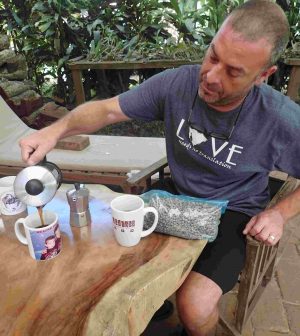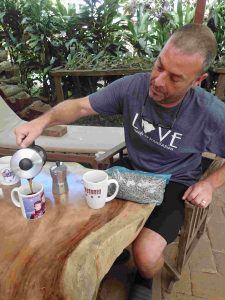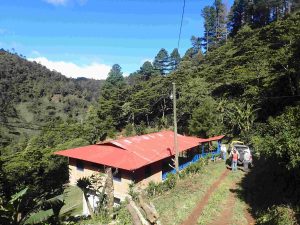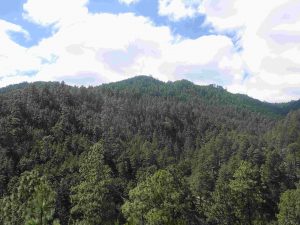- Vlog 48-This SMALL TOWN in Matagalpa has BEAUTIFUL HOUSES!Posted 1 year ago
- Vlog 47-Driving TOUR in the North City of Nicaragua “ESTELI”Posted 1 year ago
- Vlog 46- Leon during Holy Week A GREAT TIME TO VISIT!Posted 1 year ago
- Vlog 45- Moving to Nicaragua – How to Relocate SuccessfullyPosted 1 year ago
- Vlog 44-Fireworks in Leon NicaraguaPosted 1 year ago
- Vlog 43- Is it true Why No Rental Properties in Poneloya & Las Penitas NicaraguaPosted 1 year ago
- Vlog 42-This is the TRAFFIC at NIGHT in Esteli, Nicaragua.Posted 1 year ago
- Vlog 41- Cultural SHOCK in Reverse Trip to the USA from NicaraguaPosted 1 year ago
- Vlog 40-Is U.S Real Estate Market impacting Nicaragua?Posted 1 year ago
- Vlog 38- Why choosing an expensive area in Nicaragua can be a mistakePosted 1 year ago
Pat And Ted Make Divine Blended Mountain Top Coffee

By Pat Werner
Living in flat, lowland Nicaragua does not stop expats from drinking high quality Nicaraguan coffee. So old Ted and I decided to make our own exclusive blend of Nicaraguan coffees, and include coffee grown from the roof of Nicaragua. No, the roof of Nicaragua is not in Matagalpa nor Jinotepe province. Matagalpa is not really in the north of Nicaragua, but close to the geographical center of Nicaragua, with Rio Blanco the bullseye. Coffee cultivation started there in the 1870s when German immigrants, maybe encouraged by successes in Guatemala, were given governmental incentives to come to Nicaragua and grow coffee. They sort of kicked the resident Indians off their land, which caused an indian War, the War of the Castes: hostile bows and arrows on Calle Meyerbeer, the main drag of Matagalpa. It was quite a fight for a short time. Even the Jesuits got involved, siding with the Indians. President Joaquin Zavala, normally a pretty even keeled president, got miffed with the Jesuits, and kicked them out of Nicaragua, (sort of like in the movie The Mission). They came back by 1898, and rebuilt the Xalteva Church, which was probably the oldest church in Granada.
No matter, coffee was very good business, which the Nicaraguans only figured out relatively late. The Ticos, who had a non-existent colonial economy, started cultivating coffee in the first decade of the 19th century-somewhere on Avenida Central in San José, there is a plaque on a building where a coffee patch was started around 1807. The Ticos soon made commercial alliances with The British, and soon after that began to get covetous of the San Juan River as a good piece of real estate to own to ease shipping coffee to Great Britain. After all, Costa Rica had no good port, or port at all, on the Caribbean, and in those days Greytown was Nicaragua´s largest port. By the 1850s they were buying a lot of guns from the Enfield Armory and pressuring for the Rio San Juan. William Walker came along at the right time, and the Ticos used their Enfield Rifles and carbines to attack, ostensibly, forces in Nicaragua. They got beat mainly by cholera, and retreated to Costa Rica, leaving perhaps 1,000 dead Ticos buried in the sands of the beach at San Juan del Sur. They came back and helped defeat Walker. Two years later they strong armed the weak Nicaraguan Martinez government into turning over a portion of the east coast of the Rio San Juan, in the Cañas-Jerez Treaty of 1858. In some sort of weird, cosmic justice, the Ticos soon after stood both General Cañas and his brother in law their President Mora, against a wall and shot them both, around the time Walker was getting the same treatment in Puerto Cortes, Honduras.
About this time, 1860, Nicaragua finally figured out that coffee was good business, and they began feebly working to begin a coffee industry in Nicaragua, replacing many añil operations with coffee, particularly in the Sierra de Managua.
Old Ted likes fresh ground, and I like it from time to time, so we decided to search Nicaragua for the perfect blend. No we did not go to Matagalpa, the province with the largest production. We decided to begin with Carazo coffee as a base, and mix it with the coffee that wins the most prizes in tasting contests, the coffee of the Cordillera de Dipilto. The cordillera is on the border with Honduras, and is a big, beautiful chunk of granite running, floating in a huge bed of schist, or ancient mud, 60 km east and west, with the highest mountain, Mogotón, 2107 meters in elevation and with the Volcán Viejo at a bit over 1900 meters, sitting right next door. They are covered with extensive pine and oak forests that breaks into cloud forest with many fine orchids, such as one Stanhopea that smells of hot chocolate, and the full complement of tropical animals, many quetzals and tropical trogons, mountain lions, all the spotted cats, even highland tapirs and roadrunners. It also has much lore, tales of duendes, witches, many lost Spanish gold mines, and some large silver mines, which yours truly is mining to make a silver bit for my horse and silver spurs for me.
An old friend is Joaquin Lobo, who has a coffee finca on Volcan Viejo, close to the top, on a windy road that is a bit scary, muddy slippery with some 1,000 foot drop offs right next to the two tracks. There are spectacular views in every direction, and lots of liquidñambar trees, a first cousin to the sugar maple, along the road. The leaves turn red in January and look just like maple leaves. They trees´ sap is a sweet gum that is used as an ointment for burns and skin problems. The place looks to me like the eastern slope of the Rockies, which is maybe why I like it.
So one day Ted and I drove up there and visited Joaquin´s finca. He just begins the coffee harvest in January, and when we drove up, over a mile high, we found some folks depulping fresh cut coffee. On a dare, Ted bought some, and we looked over places to stay to explore those mountain passes, and maybe look for quetzals. It was noon and quite chilly and we found a cabin that is available to rent, with local guides available for quetzals and other interesting high elevation fauna. So we had some really high altitude quality coffee beans. And it is very good quality- between Joaquin, his father, and cousin, the Lobo boys have garnered several awards as having the best coffee in Nicaragua, Matagalpa and Jinotega notwithstanding. The key to the cordillera´s great coffee is that it is the highest place in Nicaragua, and the soil is sandy and acidic, which helps create the magnificent flavor of the coffee. We were half way there.
Ted and I live in Carazo, and so we wanted to use some local grown Carazo coffee, to mix into the brew. Ted is manager of an orphanage outside of Jinotepe, and has 18 manzanas to work with. Part of it is planted in old time Borbón coffee trees, which is old time quality coffee trees. While not widely known, the triangle between San Marcos, Diriamba, and Jinotepe has traditionally been known as productive of high quality coffee. The Pellas may have gotten into coffee culture in the 19th century with a coffee finca on the outskirts of San Marcos; it is still there and immaculately maintained and run. The lands in this triangle are mainly flat and with very good volcanic soil that can grow anything. My home is located on the original Rappaccioli coffee finca on the outskirts of Diriamba at 650 meters in elevation, established in 1904, and here I can grow anything.
When Ted took over the orphanage, he did not cut out the old Borbón coffee trees, and is now cultivating and fertilizing them, so he has a coffee crop. Recently, he took part of his crop, depulped it, and had local help roast it in a frying pan, old style, and how the locals make their own coffee. The trick to roasting coffee, no matter how you do it, is to take it up to 400 degrees Fahrenheit, and then cool it as fast as possible. So we roasted both the Dipilto coffee and Jinotepe coffee, mixed it and did extensive analysis, which is to say we drank a cup or two. It was first rate, and our original blended roasts are now gone. It is now our favorite coffee. We are heading north in February for historical archaeology, silver and placer mining, and also to get more fresh, en uva, beans from Don Joaquin. There is much to do.





2 Comments